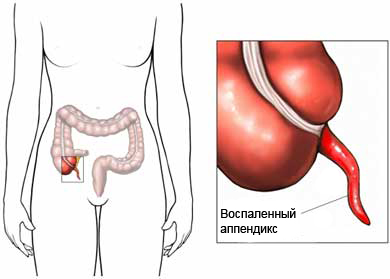Appendicitis
Description of appendicitis
Appendicitis is an inflammation of the Appendix. The appendix is a small, resembling a tube body, that hangs on the colon. He has no clear functions.

The cause of the Appendicitis
Appendicitis typically occurs, When the appendix is inflamed. This can be caused by subject, in the Processus, such as:
- Dry stool;
- Food;
- Tumor;
- Scar tissue;
- Worms;
- Barium after diagnostic examination;
- Excessive growth of lymphatic tissue vermiform process.
Appendix fabric continues to produce mucus, but she cannot pass into the intestine. Bacteria, are normally found in the intestines and multiply and produce toxins in the mucosa of the Appendix. Pressure rises and causes severe pain in the abdomen. The wall of the appendix can burst. If your appendix ruptures, its contents can get into the abdominal cavity. This causes serious inflammation in the abdomen, called peritonitis, which may be fatal.
Risk factors
Factors, that increase the likelihood of appendicitis:
- Paul: male;
- Age: Teen;
- The presence of family members, who had appendicitis.
Symptoms of appendicitis
Symptoms usually occur suddenly. The pain increases during 6-12 hours. Patients may experience some or all of the following symptoms:
- Pain:
- Discomfort around the navel disorder first;
- Discomfort usually moves to the right side of the abdomen within a few hours;
- May occur elsewhere, If the location of the Appendix an atypical;
- Gets worse when you sneeze, coughing and deep breathing;
- May increase when moving;
- Loss of appetite;
- Nausea;
- Vomiting;
- Swelling of the abdomen;
- When touching the stomach sensitivity;
- Constipation;
- Slight diarrhea;
- Slight fever.
If the appendix ruptured, symptoms include:
- The pain grows stronger and spread across the abdomen;
- The temperature of the.
Note: Symptoms may be atypical in infants, children, pregnant women and the elderly.
Diagnosis of appendicitis
You need to seek medical advice when you see a severe pain in the abdomen. Appendicitis can be difficult to diagnose. Symptoms vary and can be similar to symptoms of other diseases.
The doctor asks about the symptoms and medical history, performs a physical exam. Tests may include the following:
- Careful examination of the abdomen;
- Rectal examination.
Other Tests, to determine the cause of the pain may include:
- Blood tests, to see infection;
- Urine, to rule out urinary tract infection;
- Computed tomography or ultrasound – These tests are used, to look for signs of inflammation of the Appendix, or abscess, that can cause pain;
- Laparoscopy – a thin tube is injected through a small incision near the navel, and inspect the intestine using a special tool.
Treatment of appendicitis
Appendicitis is treated surgically. The Appendix must be removed as soon as possible. If the diagnosis is questionable, the doctor will carefully monitor the patient during 6-12 hours before surgery. The patient also give antibiotics to fight infection.
Researchers are studying, can I avoid surgery to remove the Appendix. For Example, in some studies, patients received intravenous antibiotics and were under the supervision of, instead of immediate operation.
When diagnosing appendicitis, you must follow the directions of a doctor.
Prevention of appendicitis
There are no methods to prevent appendicitis, because it occurs suddenly and causes, usually, unknown. To reduce the risk of rupture, You should seek medical help immediately, After the onset of severe pain in the abdomen.
